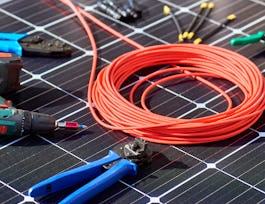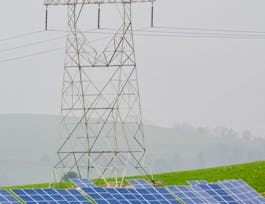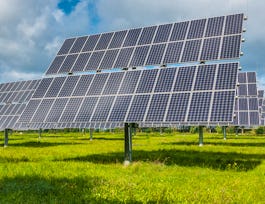By the end of this course, learners will have acquired a broad understanding of the history and mechanics behind converting light into electricity, commonly known as photovoltaics (PV). They are empowered to recognize and describe elements of a PV system, enabling them to: compare the most common types of solar cells, sketch a solar PV system, and analyze differences between rooftop and ground mounting configurations. The course explores economic considerations, touching on solar PV costs for residential and commercial use, incentives, and contrasts solar power with fossil fuel and nuclear plants.



Solar Energy Systems Overview
This course is part of Solar Energy for Engineers, Architects and Code Inspectors Specialization

Instructor: Gay E Canough
Sponsored by MAHE Manipal
21,478 already enrolled
(824 reviews)
What you'll learn
Differentiate the value of solar energy versus alternatives
Explain how PV works in technical and economic terms, and identify its components
Estimate solar system costs
Skills you'll gain
- Engineering Software
- General Finance
- Cost Accounting
- Software Development
- System Design and Implementation
- Return On Investment
- Basic Electrical Systems
- Operating Cost
- Cost Management
- Finance
- Corporate Accounting
- Electrical and Computer Engineering
- Financial Modeling
- General Accounting
- Capital Budgeting
- Computer Science
- Cost Benefit Analysis
- Environment and Resource Management
- Corporate Finance
- Engineering
Details to know

Add to your LinkedIn profile
7 assignments
See how employees at top companies are mastering in-demand skills

Build your subject-matter expertise
- Learn new concepts from industry experts
- Gain a foundational understanding of a subject or tool
- Develop job-relevant skills with hands-on projects
- Earn a shareable career certificate


Earn a career certificate
Add this credential to your LinkedIn profile, resume, or CV
Share it on social media and in your performance review

There are 5 modules in this course
What's included
1 reading
This module introduces learners to the history of solar power and the nature of photovoltaics (PV).
What's included
4 videos5 readings2 assignments1 discussion prompt
This module provides an understanding of the structure and function of different types of PV systems and their components.
What's included
13 videos5 readings2 assignments1 discussion prompt
This module provides an understanding of the costs and ROI that can be expected when installing a PV system.
What's included
4 videos6 readings2 assignments1 discussion prompt
What's included
1 assignment1 peer review
Instructor

Offered by
Why people choose Coursera for their career




Learner reviews
824 reviews
- 5 stars
76.09%
- 4 stars
19.53%
- 3 stars
3.51%
- 2 stars
0.48%
- 1 star
0.36%
Showing 3 of 824
Reviewed on Apr 22, 2021
The last quiz was too difficult. it took my time more than 1 hour . I have totally got swept .It's awesome course not only by learning materials but also difficulties. Salute the course writer.
Reviewed on Nov 12, 2022
The course very important as introduction, please make whatsup group for all who participate, we can make open seminar under the support of university of Buffalo and the lecturer
Reviewed on Aug 27, 2024
A decent introductory course. While it left me exploring a lot more on my own, the instructor was quite a pleasure to listen and seemed genuinely passionate.
Recommended if you're interested in Physical Science and Engineering

University at Buffalo

Technical University of Denmark (DTU)

The State University of New York

The State University of New York

Open new doors with Coursera Plus
Unlimited access to 10,000+ world-class courses, hands-on projects, and job-ready certificate programs - all included in your subscription
Advance your career with an online degree
Earn a degree from world-class universities - 100% online
Join over 3,400 global companies that choose Coursera for Business
Upskill your employees to excel in the digital economy


